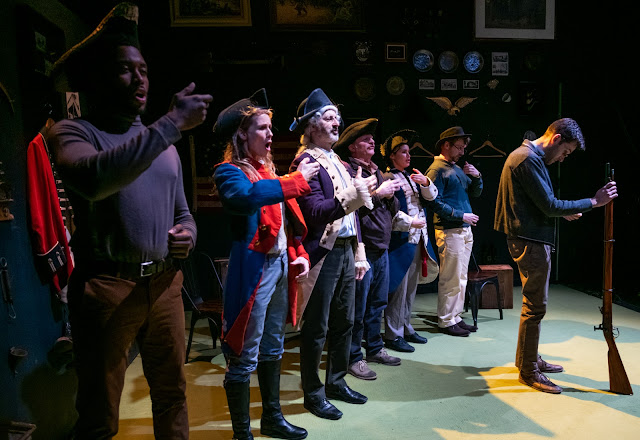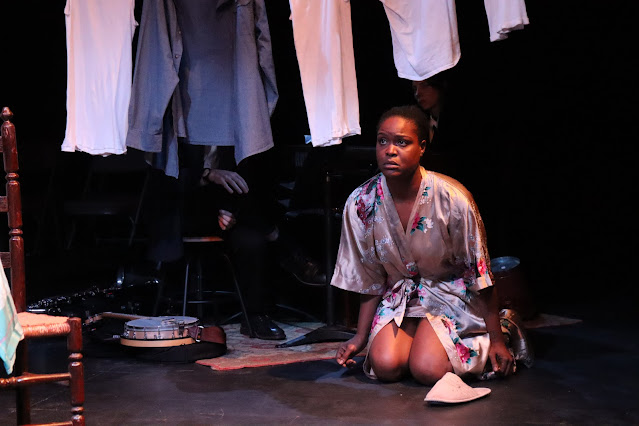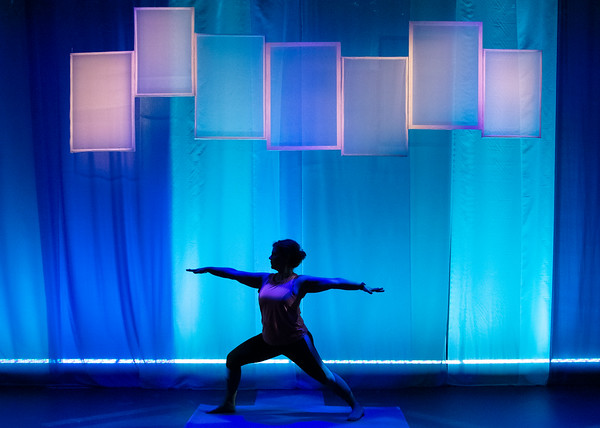Review: In "How to Load a Musket," History is a Living Thing
How to Load a Musket
Written by Talene Monahan
Directed by Jaki Bradley
Presented by Less Than Rent Theatre at 59E59 Theaters
59 E 59th St., Manhattan, NYC
January 11-26, 2020
 |
| Company, Adam Chanler-Berat in HOW TO LOAD A MUSKET at 59E59 Theaters. Photo by Russ Rowland |
How to Load a Musket proceeds by thematic groupings, and although the personal is there from the very first dialogue, set in 2015, bigger picture issues increasingly come into focus as the play evocatively limns its selection of individual subjects as it advances through time. There are factoids about the expense of reenacting and foreign tourists knowing U.S. history better than U.S. residents, description of ego clashes in a fife and drum corps, and comparisons by two different people to being a "rock star"—the sorts of quirky insularities that pervade any comparable subculture. A son (Adam Chanler-Berat) is embarrassed by his mother (Nicole Villamil) in a very funny exchange, and a scene about a couple (Richard Topol and Adam Chanler-Berat) who reenact George and Martha Washington together ends up being touchingly sweet. One of the ways that the reenactors advocate for the value of the hobby is by highlighting its ability to bring marginalized or alternate viewpoints and perspective, whether that means considering the Revolutionary War from the British side or the assertions by an African American reenactor named Lucien (David J. Cork) and by Javier (Nicole Villamil), the Puerto Rican founder of a Latinx regiment, that reenactment offers a way of telling the stories of people of color in U.S. history. Darker aspects of similar attitudes peek through, however, when topics such as Confederate monuments, states' rights and the Civil War, and keeping (the spirits of) one's ancestors alive arise. In the social side of the hobby, the reenactors would prefer to focus on dances and romance and to avoid modern politics, but it intrudes nevertheless, including in reactions to and fallout from the 2016 election. A performance artist who goes by Dread Scott (David J. Cork) says that he is (like the play itself) interested in the clash between the past and present, and one man (Ryan Spahn) argues against reenacting a slave revolt for reasons that don't sound that different than fear of slave revolt itself.
 |
| L-R: Richard Topol, Nicole Villamil in HOW TO LOAD A MUSKET at 59E59 Theaters.Photo by Russ Rowland |
What emerges from all of this is marked by complexity and a lack of easy answers that humanizes without excusing. However, while questions like those of the justness of violence and the responsiblity of the artist beyond the confines of creating her art may remain unresolved, it seems hard to argue with reenactor Hal (Ryan Spahn) when he says that reflecting on the past helps us to think about the future, a future of which, as a nation, there is not and never has been any guarantee. This idea is brought home in an illuminating moment when a man named Jeffrey (Richard Topol) characterizes the events in Charlottesville in 2017 as a skirmish in a war that we thought long over, while, outside the world of the play, the governor of Virginia has declared a state of emergency in anticipation of potential violence from, among others, militia groups at a pro-gun rally on January 20th. The play also suggests the parallels between reenactment and theater: when the reenactors mention escapism, historical research, and the experience of knowing what someone else in some other time felt, they might well be discussing theater itself. What clearer demonstration that history is representational, another form of discourse, than actors reenacting reenactors who reenact historical persons? Further, in preserving the words and voices of these reenactors, How to Load a Musket becomes a historical document itself.
The set, with its walls crowded with uniforms, paintings, and other artifacts, is fittingly reminiscent of museum displays; and, indeed, it sometimes feels like one is watching a live documentary, which is a testament to the cast's protean and uniformly rich performances. These performances can be funny, but they are never caricatures or parodies, and it's easy to imagine the real-life interviewee behind the actor. The staging also occasionally creates small, effective instances of direct engagement with the audience. As entertaining as it is thought-provoking, there is no reason not to pull the trigger on seeing How to Load a Musket.
The set, with its walls crowded with uniforms, paintings, and other artifacts, is fittingly reminiscent of museum displays; and, indeed, it sometimes feels like one is watching a live documentary, which is a testament to the cast's protean and uniformly rich performances. These performances can be funny, but they are never caricatures or parodies, and it's easy to imagine the real-life interviewee behind the actor. The staging also occasionally creates small, effective instances of direct engagement with the audience. As entertaining as it is thought-provoking, there is no reason not to pull the trigger on seeing How to Load a Musket.
-John R. Ziegler and Leah Richards



Comments
Post a Comment